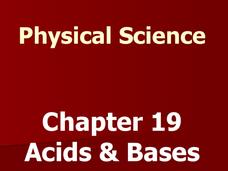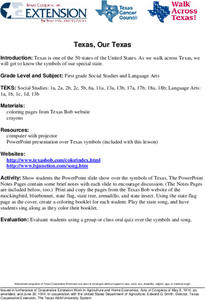Mr. E. Science
Forces
May the mass times acceleration be with you. The presentation covers forces, Newton's three Laws of Motion, momentum, and vectors.
Mr. E. Science
Thermal Energy and Heat
The presentation covers Fahrenheit, Celsius, and Kelvin scales for temperature as well as conduction, convection, and radiation.
Mr. E. Science
Sound
Since light travels faster than sound, some people may appear bright until you hear them speak. The presentation covers what sound is, how fast it travels in various mediums, properties of sound, hearing, and the parts of the human...
Mr. E. Science
Characteristics of Waves
Waves, waves, and more waves. Here, class members look at the many types and characteristics of energy waves including transverse, longitudinal, standing, seismic, p-waves, s-waves, and l-waves.
Mr. E. Science
Electricity and Magnetism at Work
I don't get electricity jokes, watts so funny about them? The 13th in a series of presentations covers energy, motors, currents, generating electricity, calculating electrical energy cost, transformers, and batteries.
Mr. E. Science
Magnetism and Electromagnetism
The biggest magnet in the world is at the Los Alamos National Laboratory in New Mexico and can reach 100 tesla. By comparison, magnets that lift cars are about two tesla. The 11th presentation in this series covers magnetism,...
Mr. E. Science
The Periodic Table
This science presentation focuses on the elements in the periodic table. It begins with the parts of an atom, explaining atomic mass and atomic number, valence electrons, and isotopes. Then it moves on to discuss various ways of...
Mr. E. Science
Light
Where does bad light end up? In a prism! The presentation covers light, mirrors, lenses, and the structure of the eye. It also provides explanations of reflection, refraction, concave and convex mirrors and lenses, and a comparison of...
Mr. E. Science
Acids, Bases and Solutions
If you are not part of the solution, then you are part of the precipitate. The presentation covers solutions, suspensions, solubility, dissociation, and acid/base reactions. This is the 19th lesson in a series of 26.
Mr. E. Science
The Earth in Space
Do you think Earth makes fun of other planets for having no life? The presentation covers the rotation and revolution of both the earth and our moon. It provides explanations for seasons, tides, and eclipses. Lesson is the 20th in a...
Mr. E. Science
Stars, Galaxies and the Universe
It takes 225 million years for our sun to travel around the galaxy. The presentation covers astronomical units, light years, telescopes, types of stars, the life cycle of a star, and types of galaxies. This is the last lesson in a...
Mr. E. Science
Our Solar System
The presentation starts with the scientists who made discoveries about our solar system: Ptolemy, Copernicus, Galileo, Brahe, Kepler, and Newton. It also covers the planets, inner, outer, and Pluto, satellites, and an in-depth discussion...
Mr. E. Science
An Introduction to Matter
What's the matter? Gas, solid, liquid, or plasma. The presentation covers how to describe and identify matter, changes in matter, types of matter, measuring matter, particles of matter, Democritus, and John Dalton's Atomic Theory.
Mr. E. Science
The Nature of Electromagnetic Waves
Imagine a presentation that covers electromagnetic waves, electromagnetic radiation, radio waves, microwaves, the visible light spectrum, UV, X-ray, and gamma rays. Here's one. Packed with facts and colorful illustrations, 11-slide...
Curated OER
Texas, Our Texas
Students watch a PowerPoint slide show of the symbols of Texas and discuss what they see. They color in coloring book pages that corrolate to the slide show. They listen to and sing along to a state song as they color.
Curated OER
Counting Game
Students play a counting game in this PowerPoint. They work as a class to identify the numbers 1-54 sequentially from a number jumble. After two minutes the slide transitions into a grid so students can see how finding data is easier...
Curated OER
Baseball Lesson: The Universe
This PowerPoint provides a look at vocabulary associated with the structure of the solar system. Students review definitions for 8 solar system terms included as well as notes about the universe.
Curated OER
Common and Proper Nouns
This PowerPoint provides a definition for and examples of common and proper nouns. After the introduction, students answer multiple choice questions by selecting either a proper noun or a common noun as indicated in each question. A...
Curated OER
Using to, two, and too
Students analyze the relationship and usage of the homophones to, two, and too. In this homophone PowerPoint the correct usage of to, two, and too is described with corresponding examples. On the last slide of the PowerPoint...
Curated OER
Typology
This typology PowerPoint focuses on having students copy and trace the given figure without lifting their pencil. There are 10 figures that students must complete.
Curated OER
The Wheels On the Bus
In this song mini-book worksheet, students see the words to the children's song, "The Wheels on the Bus." There are no questions associated with the book.
Curated OER
"Thanks a Lot Song" by Raffi
In this children's song worksheet, learners see the illustrated words to the Raffi song, "Thanks a Lot." There are no questions associated with the song.
Curated OER
Beginning Sounds
This phonics PowerPoint displays a picture and three capital letters ranging from "b" to "h" on each slide. Students click on the beginning consonant that matches the picture, then receive a smiley face or an "oops!" depending on their...
Curated OER
Anansi Goes Fishing: Compound Words
This PowerPoint gives the definition and examples of compound words. The students then identify the two words contained within in each of several illustrated compound words. Although the font and its color provide appropriate and clear...
Other popular searches
- Student Resources
- Disabled Students
- Student Protests
- Student Teacher
- Student Information Systems
- Student Authors
- Student Autobiography
- Student Motivation
- Student Leadership
- +Student Information Systems
- Students With Disabilities
- Special Education Students

























